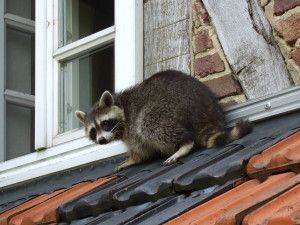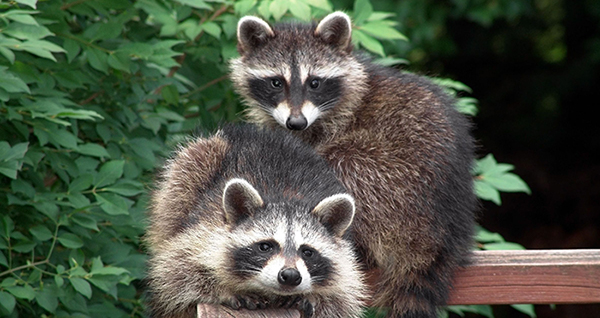
If raccoon is in an easily closed off area, like the basement or attic, block of the area so the raccoon can’t access the rest of your home, then call a raccoon removal professional as soon as possible. The animal removal company will be able to safely remove the raccoon and block off all points of entry so it can’t re-enter the home.
However, if a raccoon is in your common space like the living room or kitchen, things can get a bit trickier. Read our tips below to keep your home, family, and pets safe.
- First, remove any pets or children from the area. Raccoons typically don’t initiate any attacks, but if approached by a curious pet or child they may lash out in fear. Don’t run the risk of animal bites or scratches.
- If possible, close doors to other parts of the home. The last thing you want is the raccoon to scurry upstairs or to other areas of the house that are harder to access. You want to keep it contained to one area so you’ll know where it is.
- Do not attempt to run towards, attack, or harm the raccoon. Remember, raccoons are wild animals and don’t understand that your home and food are not meant for them to nest in and eat. They are not purposefully trying to terrorize your home; they are simply looking for food and shelter the way all animals and people do. Raccoons are not inherently aggressive, but will defend themselves and their babies if provoked.
- Since they are nocturnal animals, it’s likely that if you come face-to-face with a raccoon in your home, it will be nighttime. In broad daylight they often get confused and vulnerable so take extra precautions if dealing with a raccoon during the day.
- If a raccoon has made it into your living space, there are a few ways they may have gotten there: they may have a nest in the attic and chewed through a wall to get into the main part of the home, or they may have entered through an open door, window, or pet door. If you think the raccoon has a nest in the attic, call an animal removal professional to thoroughly address the situation. But if the raccoon seems to have just wandered in accidentally through an open door (probably lured by the smell of food), try to give it as many exit routes as possible. Open any doors that lead outside, and open windows if possible (if the window is raised, try to place something beneath it so the raccoon has something to jump up on).
- If you’re having trouble getting your guest out the door, there are a few humane ways you can hasten their exit. First, turn on all the lights; raccoons typically prefer darkness. Another way to naturally shoo them away is to make noise. Turning on the TV or radio should do the trick. Next, if possible, try to place a trail of food going to the door and into the yard to lure the animal outside. You may need to leave the room or watch from a cracked door before the raccoon feels safe to move. Once it’s out, close all possible entrances.
If you’re still having issues getting the animal out or simply feel unsafe tackling this situation alone, there’s no harm in calling an animal removal specialist! In cases where baby raccoons are involved, it’s best to have a professional handle it. Getting between a mother and her babies is bad news! If you need Austin animal removal services, you can always contact Critter Ridder at 512-363-8070. We’ll safely remove any wild animals from your home, seal up points of entry, and can even restore your attic back into mint condition if it’s been destroyed by a critter.

